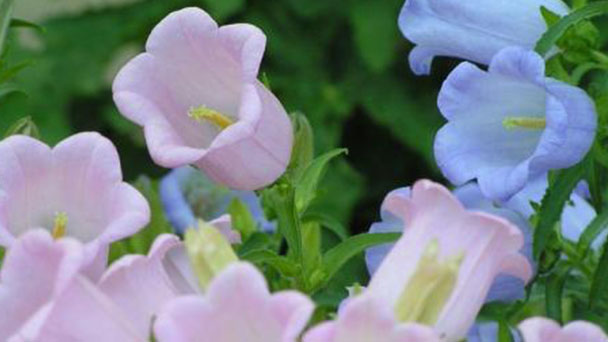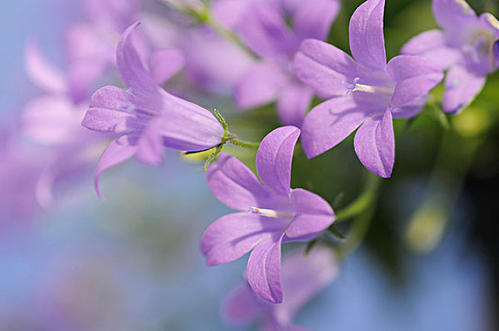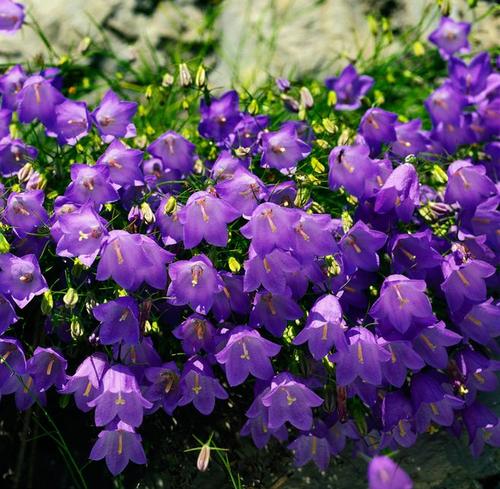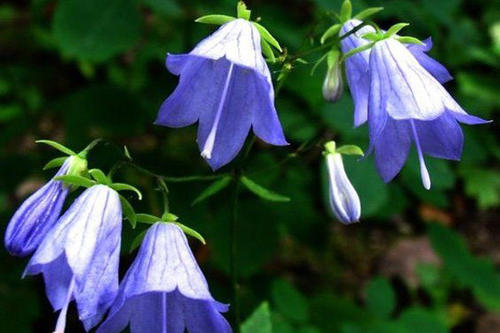Canterbury bells (cups and saucers) profile
Written by Maggie
Apr 02 2021

Canterbury Bells, also known as cups and saucers, originally from southern Europe, plant shape stout, bell-shaped flowers like bells, bright and simple but elegant, very popular in Europe, is a small garden in late spring and early summer common herbs and flowers, often with it to express health, gentle and lovely. It is still in the stage of introduction in China, but it can be seen in the flower market and art flower arrangement.
Canterbury bells picture

Canterbury bells info
| Botanical Name | Campanula medium |
| Common Names | Canterbury bells, cups and saucers |
| Plant Type | Biennial |
| Sun | Full sun to partial shade |
| Hardiness Zones | 5 to 8 |
| Flower color | Pink, white, purple, and blue |
| Native Area | Southern Europe |
| Mature size | 20 to 26 inches tall and 12 to 18 inches wide |
Morphological characteristics of Canterbury bells
Canterbury Bells is a biennial herb. Plant height about 1 m, hairy. Rosette leaves are ovate to obovate, the leaf margin is a round dentate waveform, scabrous. Petiole is winged. Cauline leaves are small and sessile. Racemes, florets 1 or 2 cauline. Corolla is bell-shaped, 5 lobed, slightly enlarged base, color has white, blue, purple and light pink, etc.
Ecological habits of Canterbury bells
Canterbury Bells originated in southern Europe. It likes cool in summer and mild in winter. Loam that is easy, fertile and well-drained.
Propagation of Canterbury bells
Canterbury bells propagates by sowing. Sow the seeds as soon as they are mature and the plants can flower the following year. If replanted in cool autumn, most seedlings will not blossom until the end of the third spring.
How to grow and care for Canterbury bells
The moisture
Let the substrate dry a little between watering, but don't let the plants wilt for lack of water.
The temperature
Nighttime 58 -- 60°F (14-60 ° C) Daytime 65 -- 70°F (18-21 ° C), when active root growth occurs, nighttime temperatures can drop to 50 -- 55°F (10-13 ° C) and remain low until the marketing season.
Fertilization
If fertilizer is needed for rapid plant growth, apply 100 to 50PPM of nitrogen.
Matrix EC value: 1.0. canterbury bells are salt-sensitive and can be used to reduce EC concentration from time to time if necessary.
Light
Canterbury Bells like the long sun and can bloom naturally for up to 14 hours a day. To bloom yearly, they need four hours of dark night for 30 days. When 15 true leaves appeared, light treatment was performed. If the Canterbury bells are too small when the light starts and treated only for primary growth, the secondary growth will be in a vigorous state of growth.
Growth regulation and heart removal: Canterbury Bells do not require growth regulation and heart removal. In the early stages of growth, Canterbury bells appear disorganized, but in the later stages of growth, the plant is naturally neat and compact.
Planting arrangement
Canterbury Bells is a cold-loving plant that should grow for several months in winter and complete its life cycle in the following spring with at least 14 hours of light per day and a long ornamental period of about 30 days from bud to bloom. If treated with long sunlight, it should be sown in November. Under natural conditions, it should be sown in January or February and grow in summer.

Disease control of Canterbury bells
Canterbury Bells susceptible to Canterbury Bells crown rot, caused by Dermatoderma cinerea, is most susceptible to infection under wet and low-temperature soil conditions. The stem of the diseased plant is gray and decayed and even dies. Discovered the disease should be promptly pulled out and burned, the disease point with lime powder or 50% of the special 1000 times the liquid irrigation.
Varieties of Canterbury bells
Canterbury bells come in a number of cultivars and seed mixes, including:
Campanula medium var. calycanthema alba: 24 to 36 inches tall; white flowers
Campanula medium Bells of Holland: 18 inches tall; pink, purple, or white flowers
Campanula medium Champion Pink: 2 feet tall; pink flowers
Campanula medium Dwarf Bella Mix: 14 inches tall; blue, lilac, pink, or white flowers
Campanula medium Double Melton Mix: 3 feet tall; flowers dark pink, light pink, or purple; double blooms
The distribution of Canterbury bells
Canterbury bells belong to more than 200 species, almost all of which are found in the north temperate zone, most of which are found in northern Eurasia and a few in North America. About 20 species in China, mainly in southwest mountainous areas, a few species in the north, a few species also in Guangdong, Guangxi and western Hubei.
Garden use of Canterbury bells
Landscape use: Canterbury Bells suitable for the small garden configuration as flower beds, flower border materials. Canterbury bells are mainly used as potted flowers, can also be used in the open flower. Canterbury Bells is suitable for the small garden configuration as a flower bed, flower border materials. If you use Canterbury Bells and ornamental sunflower as the main material, with ivy, sea gold sand, silkstone bamboo basket inserted, the performance of vibrant, thriving atmosphere of joy. If purple canterbury bells as the main flower, with white lily, delphinium, asparagus as the flower, will appear quiet and gentle.
Bed Performance: As an annual flower, Canterbury Bells overwinters in warm winter areas and can be used for borderline or edge planting in flower beds, rock gardens or gardens. Potted in a 15-20cm pot Canterbury Bells can be kept in semi-shade to full sun.

Latest Updated
- Benefits of Bugleweed - 7 Science-backed Health Benefits
- Bugleweed Dangers & Side Effects - Is It Poisonous?
- How to Plant Evergreen Trees - What You Should Know
- When to Plant Evergreens - Grow Guide for Evergreen Trees
- 12 Wonderful Evergreen Shrubs for Your Garden
- 12 Popular Evergreen Plants with Pictures for Beginners
- When And How To Prune A Lilac Bush Like a Pro
- How to Grow & Care for Lilac Vine (Hardenbergia Violacea)
- Japanese Lilac Tree (Syringa Reticulata) Care & Propagation Guide
- Shumard Oak Pros and Cons - What to Know
Popular Articles
- Winter maintenance of Antirrhinum Majus
- How to Grow Terminalia Mantaly Tree
- How to Grow and Care for Crossostephium Chinense
- How to grow Antirrhinum Majus in spring
- Peristeria Elata (Dove Orchid) Profile: Info & Care Guide
- Underwatered Snake Plant (Sansevieria Trifasciata) - Signs And How To Fix
- How to Care for Brazilian Jasmine Plant (Mandevilla Sanderi)
- How to Grow & Care for Graptopetalum Purple Delight in Summer
- Rosa Chinensis (China Rose): Plant Growing & Care Tips
- How to Care for Baby Sun Rose (Aptenia Cordifolia)